Writing Whitepapers kicks off the exploration into crafting compelling content that drives business success. Dive into the world of whitepapers with us and discover the key techniques to captivate your audience.
Explore the purpose, structure, and writing strategies necessary to create impactful whitepapers that resonate with your target audience.
Understanding Whitepapers
Whitepapers are essential documents in the business world that serve to educate readers about a specific issue, solve a problem, or present a new concept or idea. They are typically used by companies to establish thought leadership, showcase expertise, and generate leads.
Purpose of Whitepapers
Whitepapers often follow a standard structure, including a title page, table of contents, executive summary, introduction, main content with supporting evidence, conclusion, and references. They are usually longer than blog posts but shorter than a full-length book.
Target Audience
The target audience for whitepapers includes professionals, decision-makers, and individuals seeking in-depth knowledge on a particular topic. They are commonly used in industries such as technology, finance, healthcare, and marketing.
Examples of Industries
Whitepapers are commonly used in industries where complex ideas or technologies need to be explained in detail to a knowledgeable audience. For example, software companies often use whitepapers to explain new features, while financial institutions use them to analyze market trends and investment strategies.
Research and Analysis: Writing Whitepapers

Research and analysis are crucial components of creating a successful whitepaper. Conducting thorough research and analyzing data effectively are key to producing a well-informed and compelling document. Here are some methods and tips to help you with your research and analysis process.
Methods for Conducting Research
When conducting research for whitepapers, it is essential to start by defining your research objectives and identifying relevant sources of information. Utilize a combination of primary and secondary research methods to gather data. Primary research involves collecting firsthand information through surveys, interviews, or observations, while secondary research involves analyzing existing data from sources like academic journals, industry reports, and reputable websites. Be sure to critically evaluate the credibility and reliability of your sources to ensure the accuracy of your research.
Analyzing Data Effectively
Once you have gathered your research data, it is important to analyze it effectively to draw meaningful insights and conclusions. Use statistical analysis tools and techniques to identify patterns, trends, and relationships within the data. Visualize your data through charts, graphs, and tables to make complex information more digestible for your readers. Take a structured approach to data analysis, focusing on key metrics and indicators that support your whitepaper’s main arguments and recommendations.
Importance of Statistics and Case Studies
Incorporating statistics and case studies into your whitepaper adds credibility and depth to your arguments. Statistics provide empirical evidence to support your claims, while case studies offer real-world examples that demonstrate the practical application of your ideas. By including relevant statistics and compelling case studies, you can enhance the persuasiveness of your whitepaper and reinforce the validity of your recommendations.
Tips for Ensuring Information Accuracy
To ensure the accuracy of the information presented in your whitepaper, verify your sources and cross-reference data from multiple reputable sources. Fact-check all statistics, quotes, and findings to avoid inaccuracies or misinterpretations. Clearly cite your sources and provide references for readers to validate the information independently. Double-check all data and information before finalizing your whitepaper to maintain credibility and trustworthiness.
Writing Techniques

When it comes to writing whitepapers, the techniques you use can make a big difference in how your document is received. From crafting compelling introductions to presenting arguments effectively, here are some key strategies to keep in mind.
Crafting Compelling Introductions
Introductions are your chance to hook the reader and draw them into your whitepaper. Consider starting with a surprising fact, a compelling statistic, or a thought-provoking question to grab attention right from the start. Make sure to clearly Artikel what the whitepaper will cover and why it’s important for the reader to continue.
Using Visuals for Impact
Visual aids like graphs and charts can help convey complex information in a clear and engaging way. When incorporating visuals into your whitepaper, make sure they are relevant to the content and enhance the reader’s understanding. Use visuals to support your arguments and highlight key data points effectively.
Maintaining a Formal Tone
Whitepapers are typically formal documents, so it’s important to maintain a professional tone throughout. Avoid slang or overly casual language, and instead, opt for clear and concise writing that conveys your expertise on the subject matter. Remember to cite sources appropriately and use a consistent formatting style for a polished look.
Presenting Arguments and Solutions
When presenting arguments in your whitepaper, be sure to back them up with solid evidence and logical reasoning. Clearly state your position, provide supporting data or examples, and address any potential counterarguments. When proposing solutions, be specific, realistic, and actionable, outlining steps that can be taken to address the issue at hand effectively.
Formatting and Design
When it comes to formatting whitepapers, it’s essential to keep things clean and organized. Use headings, subheadings, bullet points, and numbered lists to break up the text and make it easier to read. Incorporate visuals like charts, graphs, and images to enhance understanding and engagement.
Importance of Layout and Design
The layout and design of a whitepaper play a crucial role in attracting and retaining readers. A well-designed whitepaper not only looks professional but also helps convey information effectively. Make sure to use a consistent color scheme, fonts, and spacing throughout the document to maintain a cohesive look.
- Use ample white space to avoid clutter and make the content more digestible.
- Consider using a mix of text and visuals to appeal to different types of learners.
- Create a visually appealing cover page to grab the reader’s attention from the start.
Creating Visually Appealing Whitepapers
To create visually appealing whitepapers, focus on the following aspects:
- Choose a clean and professional layout that aligns with your brand’s style.
- Use high-quality images and graphics to enhance the visual appeal of the document.
- Incorporate infographics and charts to present data in a visually engaging way.
- Experiment with different fonts and text styles to make key points stand out.
Tools for Designing Whitepapers, Writing Whitepapers
There are various tools and software available to help you design whitepapers effectively. Some popular options include:
Canva: A user-friendly design tool with templates for creating visually stunning whitepapers.
Adobe InDesign: A professional design software for creating custom layouts and designs.
Microsoft Word: While not as advanced as other tools, Word offers basic design features for creating simple whitepapers.
